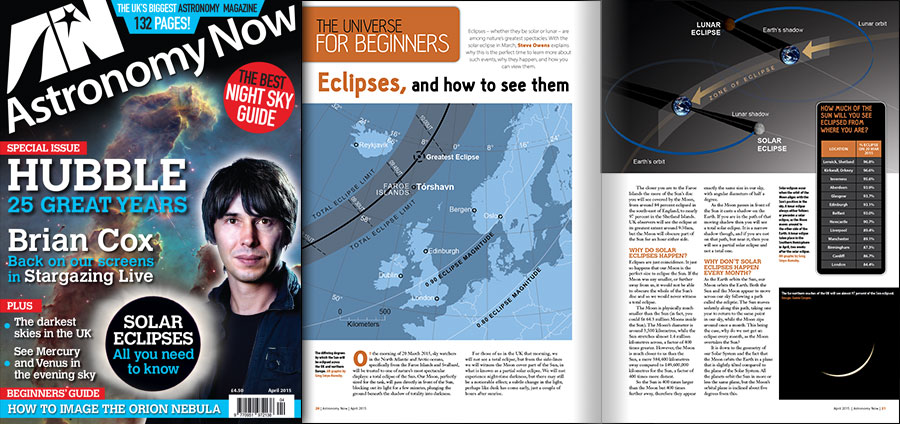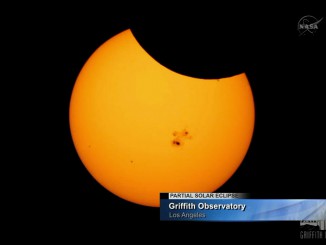
You may be surprised to learn that there can be as many as seven solar and lunar eclipses around the world in any one year, but not all of them will be total. The next instance of this is in 2038 when there will be four lunar and three solar eclipses (only one solar being total). Furthermore, in 1935 there were five solar eclipses — four partial and one annular — but in ‘normal’ years such as 2015, there will be two solar and two lunar eclipses.
It is also possible to have three eclipses in a single lunar month — the period between successive New or Full Moons — but that won’t happen again until July-August 2018 (solar, followed by lunar, then solar). Three eclipses in a calendar month is particularly rare; we have to wait until 2206 for the next instance of that.
While many of us have indelible memories of the last total eclipse of 11th August 1999 over Cornwall and South Devon, the next time the UK mainland will see the Sun fully extinguished by the Moon is close to sunset on 23rd September 2090 — yes, sadly, we all have quite a wait! At least the younger among you reading this will be alive to see it in 75 years time. (The total eclipse of 3rd September 2081 is visible from the Channel Islands).
However, don’t be too discouraged — there are some forthcoming eclipses that won’t require a passport to see. Here is a list of partial eclipses visible from the British Isles over the next 15 years, the trend favouring those observers in the north and west of the UK:
11th August 2018
The morning partial eclipse of 11th August 2018 is only visible from the extreme north of Scotland. The Orkney and Shetland Islands are favoured, but even here the percentage of Sun obscured will only be around 5%. The graphic shows a computer simulation of the filtered naked-eye view from Shetland at 08:45 UT.
10th June 2021
The morning annular eclipse of 10th June 2021 is partial over the entire British Isles, but the northwest of Scotland is favoured where the percentage of Sun obscured approaches 50%; it is nearer 30% in the southeast of England. This illustration shows a computer simulation of a filtered naked-eye view from Glasgow at 10:20 UT.
25th October 2022
The morning partial eclipse of 25th October 2022 favours the northeast of Scotland where the percentage of Sun obscured by the Moon is around 35%. From the southern tip of Cornwall around 15% of the Sun’s disc is covered. This illustration shows a computer simulation of a filtered naked-eye view from Aberdeen at 09:50 UT.
12th August 2026
The total eclipse of 12th August 2026 is seen as a deep partial from the UK during the evening, where the west of Ireland is favourably placed and 95% of the Sun is obscured. In London, around 83% of the Sun is covered by the Moon. This image shows a computer simulation of the naked-eye (filtered) view from Sligo at 18:10 UT.
2nd August 2027
The total eclipse of 2nd August 2027 is seen as partial from the southern counties of England during the morning, where the percentage of Sun obscured is around 55%. From the tip of Scotland, around 30% of the Sun is covered by the Moon. This illustration shows a computer simulation of the naked-eye (filtered) view from London at 09:00 UT.
26th January 2028
The annular eclipse of 26th January 2028 is seen close to sunset from the UK, where the west of the country is favoured. This is a computer simulation of a filtered naked-eye view from Cork in Ireland at 16:30 UT.
1st June 2030
The annular eclipse of 1st June 2030 is seen as partial in the early morning from the UK, where the southeast is favoured and 60% of the Sun is obscured. From Scotland, around 50% of the Sun will be covered by the Moon. This is a computer simulation of a filtered naked-eye view from Norwich at 05:20 UT.
Inside the magazine
In the April 2015 issue of Astronomy Now, we tell you everything you need to know about solar eclipses. Get your copy in the shops or order online.
Never miss an issue by subscribing to the UK’s biggest astronomy magazine. Also available for iPad/iPhone and Android devices.




